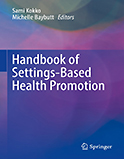Handbook of Settings-Based Health Promotion

Author: Sami Kokko, Michelle Baybutt
Affiliation: Sami Kokko, University of Jyväskylä, Jyväskylä, Finland; Michelle Baybutt, University of Central Lancashire, Preston, UK
Publisher: Springer Nature
Publication Date: 2022
ISBN 10: 3030958558
ISBN 13: 9783030958558
eISBN: 9783030958565
Edition: 1st
Affiliation: Sami Kokko, University of Jyväskylä, Jyväskylä, Finland; Michelle Baybutt, University of Central Lancashire, Preston, UK
Publisher: Springer Nature
Publication Date: 2022
ISBN 10: 3030958558
ISBN 13: 9783030958558
eISBN: 9783030958565
Edition: 1st
Description:
This book's central focus is to provide academics, students, policy-makers, and practitioners with a unique insight into a wide variety of perspectives on settings-based health promotion. It offers clarity amidst different interpretations and ideological understandings of what applying a settings-based approach means. Emphasis is given to a salutogenic focus, exploring how the creation of wellbeing and fostering of potential in settings to best enable individuals and populations to flourish implies that the setting itself must be the entry point for health promotion. Building on this, the text explores how the settings approach to health promotion strives for changes in the structure and ethos of the setting – detailing how changes and developments in people's health and health behavior are easier to achieve if health promoters focus on settings rather than solely on individuals.
The book comprises 15 chapters organized in three sections:
In Part I, Evolution, Foundations and Key Principles of the Settings-Based Approach, the first four chapters present the determinants, theoretical basis, and generic commonalities that are consistent over various settings initiatives and formulate the grounds for the settings-based health promotion approach.
In Part II, Applying the Settings-Based Approach to Key Settings, Chapters 5-13 introduce the key settings initiatives – both traditional and non-traditional (new and contemporary) – with their developments and specific features.
In Part III, Gaia – The Ultimate Setting for Health Promotion, the last two chapters consider the settings approach in the context of future challenges and explore possible directions for further development.
Handbook of Settings-Based Health Promotion has novel information and perspectives on the topic that provide readers with up-to-date specialist knowledge and application of global developments to develop and enhance a common understanding and generate new thinking in relation to contemporary settings. This timely tome will engage the academic community in the fields of health promotion and public health including students, teaching staff, and researchers. Additionally, it is a useful resource for policy-makers and practitioners in these fields.
Related Titles
